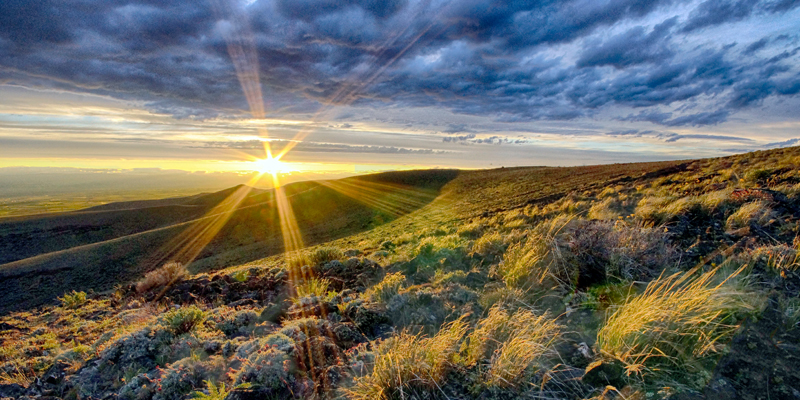
South Central - Region 3
1701 South 24th Avenue
Yakima, WA 98902-5720
United States
Fishing tips and news
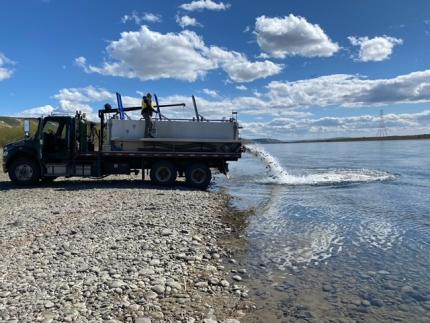
Salmon and steelhead
The spring season closes May 2 for salmon and steelhead fishing, but salmon and steelhead hatchery staff have been busy stocking up for next year! For example, Ringold Hatchery is stocking yearling Coho and Steelhead. Ringold releases up to 180,000 Steelhead smolts averaging around 8 inches long and 250,000 yearling Coho smolts averaging around 6 inches long every year in April. The Steelhead will return in in two years average as well as the coho. Soon they will receive up to 4.5 million fall Chinook for release in June. Once they are released, these fish will provide fishing opportunities for up to the next 5 years.
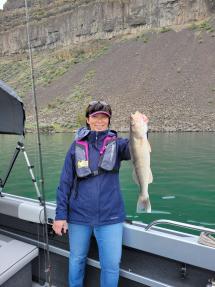
Walleye
Fishing for walleye will continue to improve over the next couple of months. Lots of good water from The Dalles upstream to Wanapum in the Columbia River, Lake Herbert G West (Lower Monumental Reservoir) in the Lower Snake River, plus Moses Lake, Potholes Reservoir, Scooteney, Banks Lake, and finally Lake Roosevelt. It’s a good time to plan a trip.
Trout
The annual lowland lakes trout fishing season opened April 27, along with the annual WDFW Trout Derby where you can win all kinds of prizes along with your catch. Check our Derby webpage for details.
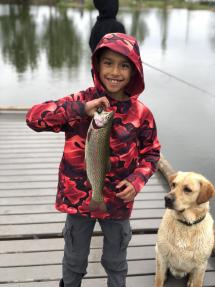
WDFW stocks trout in many lakes throughout the year, and opening day marks the first time people can fish many of those lakes for the catchable trout planted every winter and spring. Opening-day lakes are often stocked shortly before the start of their six-month season. Visit WDFW’s website to see which lakes have been stocked in recent weeks and sort by county or waterbody to find a nearby stocked lake. Most jumbo trout are planted in March and April, with others saved for fall planting.
Depending on the lake, people may encounter rainbow trout, cutthroat trout, kokanee salmon, and other fish species. Many lakes in the south-central region are open year-round, so catchable-size trout plants began much earlier than other areas of the state.
A catch-and-release trout fishery is open year-round on the Yakima River from Roza Dam to Easton Dam under selective gear rules. Fishing is closed above Easton Dam until the Saturday before Memorial Day.
Also, anglers can start making plans for Washington’s statewide rivers, streams and beaver ponds that open May 25 through Oct. 31. Beaver ponds located within or connected to streams listed as open to trout and other game fish follow the same rules as the stream. Be sure to check for special regulations by clicking here.
White sturgeon
The Columbia River and Snake River above McNary Dam are open year-round for catch and release sturgeon fishing, with seasonal closures affecting several reaches. Sturgeon sanctuaries located immediately downstream of the lower Columbia River dams and Ice Harbor Dam on the Snake River go into effect May 1 through August 31. No fishing, not even catch-and-release, is allowed within these sanctuaries during these months to allow mature sturgeon to spawn and recover. Please review the Washington Sport Fishing Rules for additional restrictions on sturgeon fishing including the upstream section of the Hanford Reach.
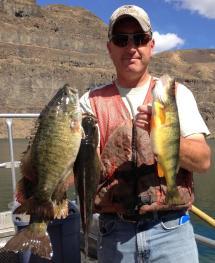
Bass, catfish, and perch, heating up
Catch rates should improve on area rivers for smallmouth bass, channel catfish and walleye through spring. Some of the year’s best fishing for channel catfish and smallmouth bass will be in May in the Yakima, Palouse, and Walla Walla rivers. Perch are in the midst of spawning in backwater areas along the margins of the Columbia River near Paterson, and catch rates are very good with many in the 11-13 inch range. Although, smaller than walleye they are plentiful, easy to catch, just as tasty, and there’s no bag or size limit in the Columbia River. Check for specific rules and regulations and what river areas are open for fishing.
Please review the sport fishing rules for catch limits and other information and check the WDFW website for emergency regulations.
New license reminder
Now that it’s spring, Washingtonians must have new 2024-2025 recreational hunting and fishing licenses. Those age 15 or older must have an applicable fishing and/or shellfish license. Licenses are available by phone at 360-902-2464 or online, and from license dealers around the state.
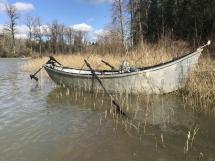
Boating safety
With fishing season openers in April, the Washington State Parks and Recreation Commission Boating Program reminds you to take a boater safety education course, if you haven’t already, to be prepared for the season. In Washington, boaters who operate a vessel with a 15-horsepower engine or greater must carry a Boater Education Card to prove they passed an accredited boating safety education course. Keep in mind that wearing a flotation device in, on or around water saves lives as drowning is one of the leading causes of fatalities, especially among young children.
Hunting opportunities and news
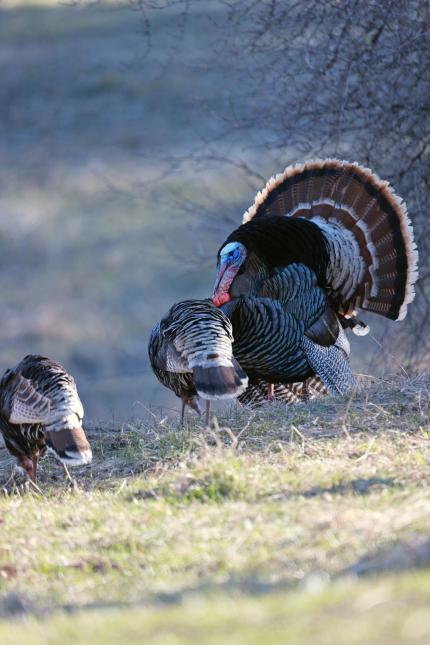
Spring turkey hunting
The statewide spring wild turkey hunting general season is open through May 31, 2024. Hunters may ONLY harvest male turkeys and turkeys with visible beards. For more information, visit the Wild Turkey hunting webpage, and click here for hunting prospects. WDFW provides public hunting opportunity not just on Wildlife Area lands but also on private lands enrolled in the Private Lands Access Program.
Another important restriction for Region 3 is that hunters may only harvest 1 turkey in either Kittitas or Yakima counties. Lastly, hunters are required to report their turkey hunting activity by January 31, 2025. These reports are important for monitoring and management of our game species, so hunters are encouraged to report as soon as possible to decrease chances of forgetting.
Special hunt permit application
Hunters can submit special hunt applications through May 15 for deer, elk, mountain goat, moose, bighorn sheep, and fall turkey seasons. WDFW will conduct a drawing from this year’s applicants to select 2024 permit winners. Hunters who successfully draw a special permit gain the opportunity to hunt at special times or places, opportunities for ages and sexes of wildlife not usually allowed in general season hunts and hunting opportunities for species which aren’t abundant enough to allow general hunting seasons. Special hunt permits offer a chance to participate in a unique hunt while directly supporting conservation and management in Washington.
To apply for a deer or elk special permit, hunters must first buy a hunting license before applying with their preferred hunt choices. Applicants for mountain goat, moose, and bighorn sheep do not need to buy a license before they apply.
Access instructions and details on applying for special permit hunts in Washington’s 2024 Big Game Hunting Seasons and Regulations pamphlet, available on WDFW's website and in print at dealer locations across the state, and on the vendor website later this month.
Hunters can buy applications and licenses from license vendors, at regional offices, on WDFW's WILD system, or by calling 360-902-2464. Hunters must submit applications at https://fishhunt.dfw.wa.gov/login. Hunters can also purchase a variety of general season licenses at these locations for hunting opportunities that do not require a special permit. Hunters buying and applying online must create a username and password in the Department’s WILD system if they have not already done so.
WDFW will post the results of the special hunt permit drawing online by the end of June. Drawing results will be posted to applicants’ WILD accounts in June. Applicants with a valid email will also receive an email alert when the results are available.
Reporting your harvest
Mandatory hunter harvest reporting allows the Washington Department of Fish and Wildlife to better manage game species throughout the state and set permit levels for upcoming seasons. This in turn allows for more hunting opportunities. For more information, visit the hunting reporting webpage.
Wildlife watching and recreation
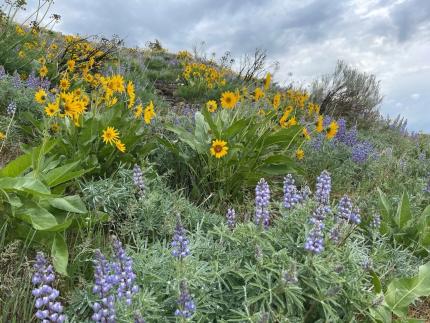
Wildflower viewing
Spring is usually an excellent time to be dazzled by wildflowers in South Central Washington. This month holds a lot of promise for viewing and photographing a bright pop of shrub steppe wildflowers and most of the low elevation areas are typically pretty good.
Places to view wildflowers on WDFW land are in the Oak Creek Wildlife Area (Waterworks Canyon, Bear Canyon, and Tieton River Trail, as well as parts of the Cowiche Unit in the Oak Creek Wildlife Area); the Wenas Wildlife Area (Black Canyon and Skyline Trails); and the LT Murray Wildlife Area (Quilomene and Whiskey Dick units). In fact, you can find early spring wildflowers putting on a show all the across Washington that are noteworthy of a visit as the season begins to change. phlox, balsam root, lupine, bitterroot, biscuit root, and many others are in full bloom.
Gates open for wildlife viewing
Starting May 1 at 6 a.m., WDFW will open the gates to winter closure areas on the Oak Creek, Wenas, L.T. Murray, and Colockum wildlife areas. Portions of these wildlife areas closed in winter to protect elk and other species from human disturbances will again be open to those who want to spend some time in Washington’s backcountry. Be aware that other land management agencies or private lands that allow recreational access may have seasonal gates that open on different dates or times. WDFW only manages gates in their direct control.
Visitors are required to display a current WDFW Vehicle Access Pass or Discover Pass for vehicle access to all WDFW lands and boat launches. Information about purchasing a state Discover Pass is available on the Discover Pass website.
Most of these areas are part of a cooperatively managed “Green Dot” road management system, which allows vehicle travel on the roads marked with a round green reflector on a white route marker, providing access for camping, hunting, wildlife viewing, and other uses, while protecting fish and wildlife and their habitats. Green Dot Maps are now available for download from the WDFW’s Green Dot page, and along with a free app, can be used on your smartphone to track your location on the map so you always know where you are. Areas included in the “Green Dot” system are delineated on the green dot maps. Some roads on the wildlife areas are still snow covered at high elevations. To protect roads and resources, WDFW is asking visitors not to drive on soft, wet roads and to use caution.
Four gates open May 1 at 6 a.m. at the Oak Creek Wildlife Area, located seven miles west of Naches. One is a vehicular restriction only gate at the top of Cleman Mountain that accesses the Mud Lake and Sanford Pasture areas. The other three include the U.S. Forest Service, 1400 Oak Creek Road and two provide access to the Bethel Ridge Tie Green Dot Road. The winter closure areas within the Oak Creek and Cowiche units will also open to the public at the same time.
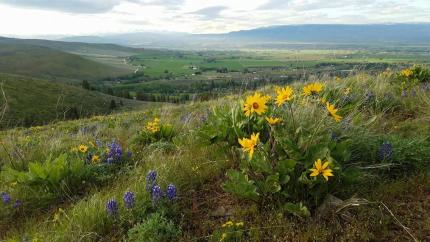
Located 18 miles west of Selah, the Mellotte gate at the Wenas Wildlife Area opens May 1 at 6 a.m. providing access to the north side of Cleman Mountain. The area holds a range of habitat including riparian zones, shrub-steppe, and forestlands.
At the L.T. Murray Wildlife Area, Joe Watt and Robinson gates open May 1 at 6 a.m. The Whiskey Dick unit east of Ellensburg also opens at 6 a.m. that day.
At the Colockum Wildlife Area south of Wenatchee, the West Bar Road opens to vehicle traffic May 1. Although the road is only 2.5 miles long, it provides access to the Columbia River.
There are no developed campgrounds in any of these areas, and campfires are prohibited through Oct. 15.
Foraging for food
Wild mushrooms are out and some lucky foragers have been gathering good numbers of tasty morels on the Wildlife Areas. Ticks are also out. Wear lighter clothing, repellents, and check yourself and your gear to avoid carrying home these little hitchhikers.
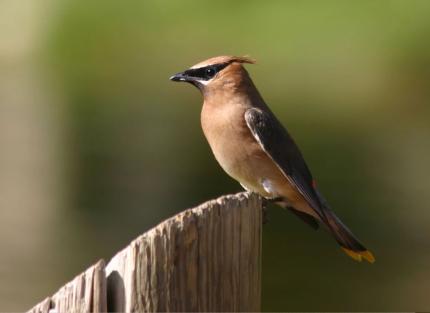
Explore a birding event or site near you
Right now, is the best time for migrating songbirds and raptors in the area. The Lower Columbia Basin Audubon Society bird walks are aimed at beginning birders. Click here for more information.
The International Migratory Bird Day is May 11 near the peak of many bird migrations, with birdwatchers looking for hundreds of bird species moving from their wintering grounds south of the U.S. border to nesting habitats in North America. Look for local birding events this month and next through the IMBD website or through local Washington Audubon chapter websites. You can also track other sightings or share your own bird observations on May 11th as part of the eBird Global Big Day.
Find the best places for bird watching in South Central Washington by exploring routes along the Great Washington State Birding Trail. The Sun and Sage Loop features 53 main sites to see mountain golden eagles, bald eagles, cedar waxwings, dark-eyed juncos, American white pelicans, and more.
Amphibians and reptiles
Did you know Washington is home to at least 25 species of amphibians (salamanders and frogs) and 28 reptiles (turtles, snakes, and lizards)? If you hadn’t noticed there’s a lot of ribbit-ribbit, croaking, trilling, hopping, and slithering happening right now around ponds, waterways, and greenbelts. Amphibians and reptiles are both important members of aquatic (water) and terrestrial (land) ecosystems, and they may use different habitats throughout the year, and it is especially noticeable and visible during spring. Click on the WDFW amphibian and reptile webpage or the species webpage to find out more information.
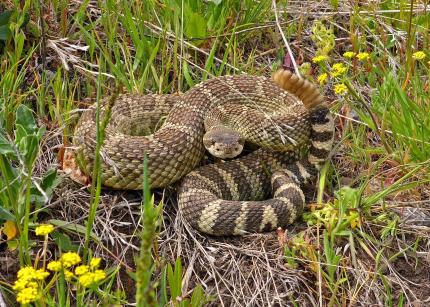
Negative wildlife interactions
May is a busy month for the birth of baby animals. A reminder that if you run into fawns, baby birds, or other young animals, please leave them be, even if they appear to be orphaned or abandoned. Most animals have a parent foraging or hunting nearby. Click on this link to read about living with wildlife.
Rattlesnakes and Bull Snakes have been observed this spring on the Wildlife Areas. Be cautious in brushy areas where visibility to the trails is restricted. Give them space if encountered.
Black bears have also emerged from their winter dens hungry and in search of calories after months of not eating. During this time of increased activity, we're asking for your help to secure un-natural food sources to reduce bear encounters – especially around your home or while on the trail.
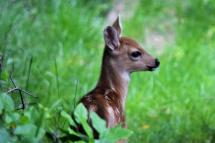
Leave wild babies wild
Every year we see people who want to “help” young wildlife but just because baby animals are alone does not mean they need help. If you find fawns, baby birds, or other young animals, please leave them be, even if they appear to be orphaned or abandoned. Most animals have a parent foraging or hunting nearby. Read our blog to learn about when not to rescue wildlife and what to do if you encounter certain species.
Report bat observations
Have you seen a bat flying during the day or in freezing weather? These could be signs of a serious disease called white-nose syndrome. Please report your observations online or call 360-902-2515. White-nose syndrome does not pose a threat to humans, pets, or other wildlife.
#LifeOutdoorsWA
Share your outdoor adventures! Send us your best #LifeOutdoorsWA photos of how you spend time outdoors! Your photos may be featured on WDFW’s Facebook and Instagram to celebrate the variety of ways people enjoy outdoor lifestyles and to inspire others to spend time in nature.
Conserving species and habitats
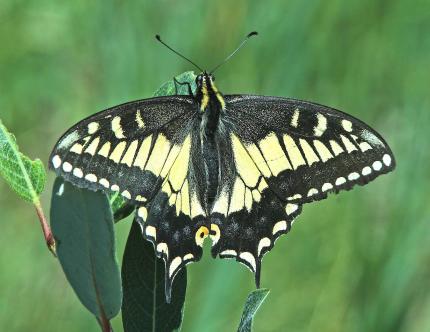
Habitat at Home
Support wildlife, mow less, and conserver water by transforming your lawn! Grassy lawns have replaced healthy wildlife habitat and contribute to water shortages across Washington. Transforming your lawn into a native wildflower meadow creates habitat for pollinators, birds, and bats. Plus, the native plants need much less water than a conventional lawn! View this document for ways to transform your lawn.
Backyard wildlife activities
Learn how to landscape for wildlife: Vegetation is key to attracting a variety of wildlife. Native plants provide the food, shelter, and nesting habitat for songbirds, hummingbirds, butterflies, bees, and other wildlife. You can use this extra time at home to map out how you’d like your property to look and figure out which plants would thrive where you live. Visit the Washington Native Plant Society’s website for resources.
Add a water source to your yard: Put in a birdbath, garden pond, or other source of water outside your home. A safe place to bathe and drink will act as a magnet to many animals. You can make a simple birdbath with things you probably already have. Visit the Audubon’s website for an easy do-it-yourself bird bath using an old cake pan or flower-pot tray.
Build a bird house or nest box: Add bird houses to your property, or better yet, try to leave snags (dead trees) if they don’t pose any risk. Cavity-nesting birds have been especially impacted by urban development. A bird house of the proper dimensions can substitute for snags where these birds used to nest. There are lots of easy instructions online to build your own bird house or nest box. Visit the U.S. Fish and Wildlife Service’s Backyard Birding webpage for resources.
Wildlife Program biweekly reports
To read reports published prior to 2023, visit the Biweekly Wildlife Program activity reports page.
Meet your Regional Director - Mike Livingston
Central Region Director
Mike Livingston, the South Central Regional Director (Region 3) grew up fishing, hunting and playing in the forests of southeast Michigan. He received a bachelor’s degree in Conservation from Northern Michigan University, a bachelor’s degree in Fish and Wildlife Management from Michigan State University and a master’s in Wildlife Science from New Mexico State University.
Since 1996 Mike has worked in eastern Washington and held wildlife biologist positions with the Army’s Yakima Training Center, the Yakama Nation, and WDFW as District Wildlife Biologist in the Tri-Cities. In 2012, he was promoted to his current position as WDFW’s Region 3 Director. As Regional Director, he oversees operations in the region and gets to work on big collaborative conservation projects such as the Yakima Basin Integrated Plan. When not working, you can often find him outside with his: family, friends, dog, shotgun, fishing rod, and/or backpack.